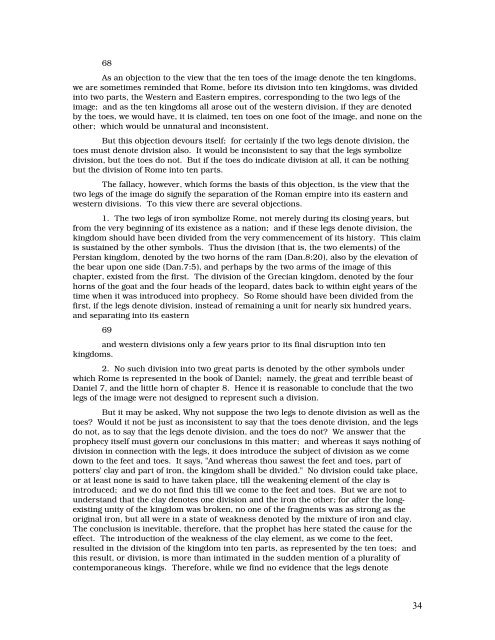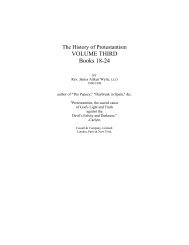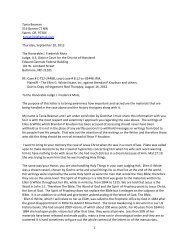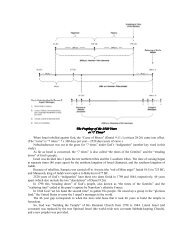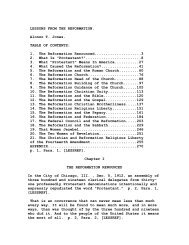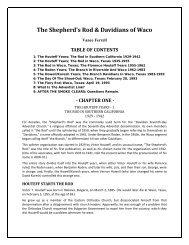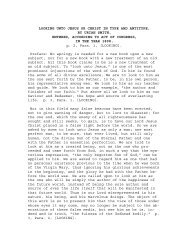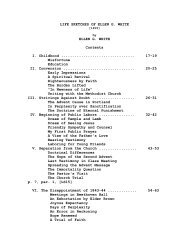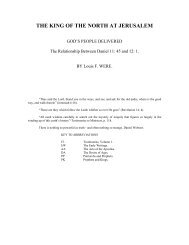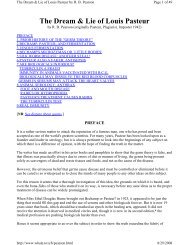Daniel and the Revelation. Uriah Smith
Daniel and the Revelation. Uriah Smith
Daniel and the Revelation. Uriah Smith
You also want an ePaper? Increase the reach of your titles
YUMPU automatically turns print PDFs into web optimized ePapers that Google loves.
68<br />
As an objection to <strong>the</strong> view that <strong>the</strong> ten toes of <strong>the</strong> image denote <strong>the</strong> ten kingdoms,<br />
we are sometimes reminded that Rome, before its division into ten kingdoms, was divided<br />
into two parts, <strong>the</strong> Western <strong>and</strong> Eastern empires, corresponding to <strong>the</strong> two legs of <strong>the</strong><br />
image; <strong>and</strong> as <strong>the</strong> ten kingdoms all arose out of <strong>the</strong> western division, if <strong>the</strong>y are denoted<br />
by <strong>the</strong> toes, we would have, it is claimed, ten toes on one foot of <strong>the</strong> image, <strong>and</strong> none on <strong>the</strong><br />
o<strong>the</strong>r; which would be unnatural <strong>and</strong> inconsistent.<br />
But this objection devours itself; for certainly if <strong>the</strong> two legs denote division, <strong>the</strong><br />
toes must denote division also. It would be inconsistent to say that <strong>the</strong> legs symbolize<br />
division, but <strong>the</strong> toes do not. But if <strong>the</strong> toes do indicate division at all, it can be nothing<br />
but <strong>the</strong> division of Rome into ten parts.<br />
The fallacy, however, which forms <strong>the</strong> basis of this objection, is <strong>the</strong> view that <strong>the</strong><br />
two legs of <strong>the</strong> image do signify <strong>the</strong> separation of <strong>the</strong> Roman empire into its eastern <strong>and</strong><br />
western divisions. To this view <strong>the</strong>re are several objections.<br />
1. The two legs of iron symbolize Rome, not merely during its closing years, but<br />
from <strong>the</strong> very beginning of its existence as a nation; <strong>and</strong> if <strong>the</strong>se legs denote division, <strong>the</strong><br />
kingdom should have been divided from <strong>the</strong> very commencement of its history. This claim<br />
is sustained by <strong>the</strong> o<strong>the</strong>r symbols. Thus <strong>the</strong> division (that is, <strong>the</strong> two elements) of <strong>the</strong><br />
Persian kingdom, denoted by <strong>the</strong> two horns of <strong>the</strong> ram (Dan.8:20), also by <strong>the</strong> elevation of<br />
<strong>the</strong> bear upon one side (Dan.7:5), <strong>and</strong> perhaps by <strong>the</strong> two arms of <strong>the</strong> image of this<br />
chapter, existed from <strong>the</strong> first. The division of <strong>the</strong> Grecian kingdom, denoted by <strong>the</strong> four<br />
horns of <strong>the</strong> goat <strong>and</strong> <strong>the</strong> four heads of <strong>the</strong> leopard, dates back to within eight years of <strong>the</strong><br />
time when it was introduced into prophecy. So Rome should have been divided from <strong>the</strong><br />
first, if <strong>the</strong> legs denote division, instead of remaining a unit for nearly six hundred years,<br />
<strong>and</strong> separating into its eastern<br />
69<br />
<strong>and</strong> western divisions only a few years prior to its final disruption into ten<br />
kingdoms.<br />
2. No such division into two great parts is denoted by <strong>the</strong> o<strong>the</strong>r symbols under<br />
which Rome is represented in <strong>the</strong> book of <strong>Daniel</strong>; namely, <strong>the</strong> great <strong>and</strong> terrible beast of<br />
<strong>Daniel</strong> 7, <strong>and</strong> <strong>the</strong> little horn of chapter 8. Hence it is reasonable to conclude that <strong>the</strong> two<br />
legs of <strong>the</strong> image were not designed to represent such a division.<br />
But it may be asked, Why not suppose <strong>the</strong> two legs to denote division as well as <strong>the</strong><br />
toes? Would it not be just as inconsistent to say that <strong>the</strong> toes denote division, <strong>and</strong> <strong>the</strong> legs<br />
do not, as to say that <strong>the</strong> legs denote division, <strong>and</strong> <strong>the</strong> toes do not? We answer that <strong>the</strong><br />
prophecy itself must govern our conclusions in this matter; <strong>and</strong> whereas it says nothing of<br />
division in connection with <strong>the</strong> legs, it does introduce <strong>the</strong> subject of division as we come<br />
down to <strong>the</strong> feet <strong>and</strong> toes. It says, "And whereas thou sawest <strong>the</strong> feet <strong>and</strong> toes, part of<br />
potters' clay <strong>and</strong> part of iron, <strong>the</strong> kingdom shall be divided." No division could take place,<br />
or at least none is said to have taken place, till <strong>the</strong> weakening element of <strong>the</strong> clay is<br />
introduced; <strong>and</strong> we do not find this till we come to <strong>the</strong> feet <strong>and</strong> toes. But we are not to<br />
underst<strong>and</strong> that <strong>the</strong> clay denotes one division <strong>and</strong> <strong>the</strong> iron <strong>the</strong> o<strong>the</strong>r; for after <strong>the</strong> longexisting<br />
unity of <strong>the</strong> kingdom was broken, no one of <strong>the</strong> fragments was as strong as <strong>the</strong><br />
original iron, but all were in a state of weakness denoted by <strong>the</strong> mixture of iron <strong>and</strong> clay.<br />
The conclusion is inevitable, <strong>the</strong>refore, that <strong>the</strong> prophet has here stated <strong>the</strong> cause for <strong>the</strong><br />
effect. The introduction of <strong>the</strong> weakness of <strong>the</strong> clay element, as we come to <strong>the</strong> feet,<br />
resulted in <strong>the</strong> division of <strong>the</strong> kingdom into ten parts, as represented by <strong>the</strong> ten toes; <strong>and</strong><br />
this result, or division, is more than intimated in <strong>the</strong> sudden mention of a plurality of<br />
contemporaneous kings. Therefore, while we find no evidence that <strong>the</strong> legs denote<br />
34


